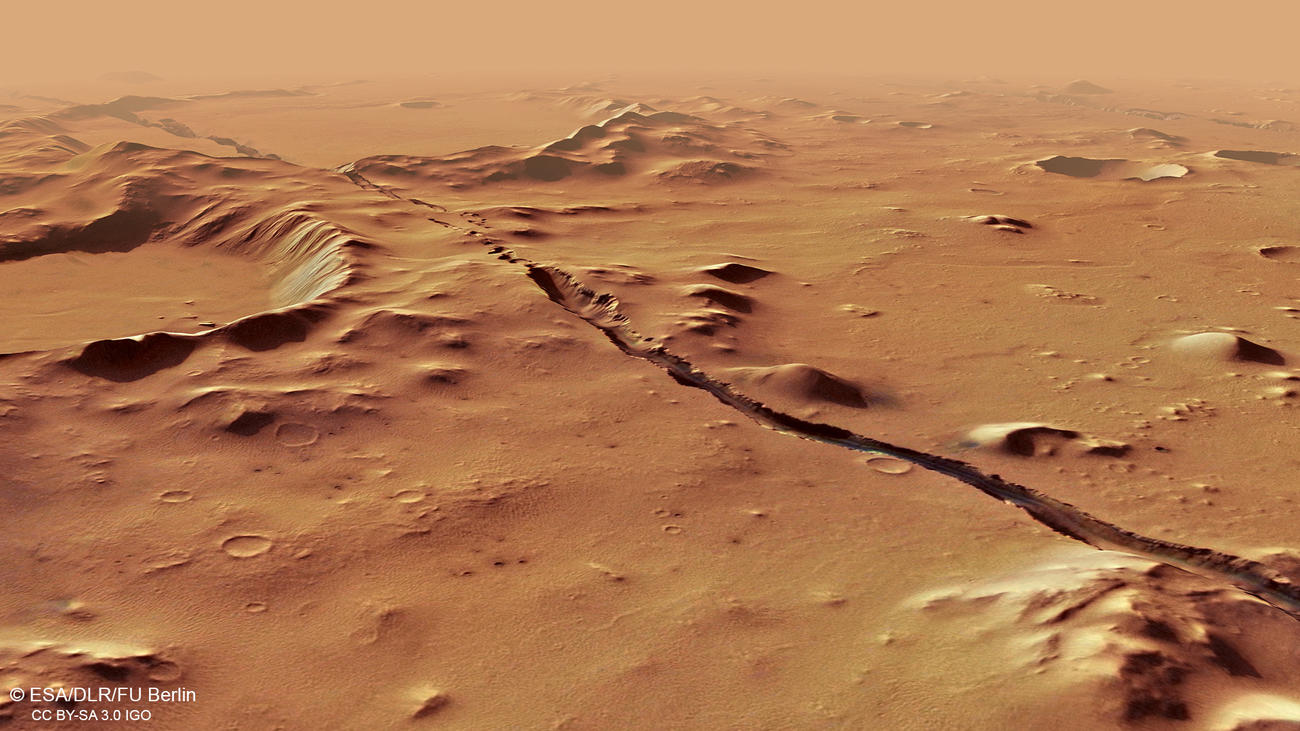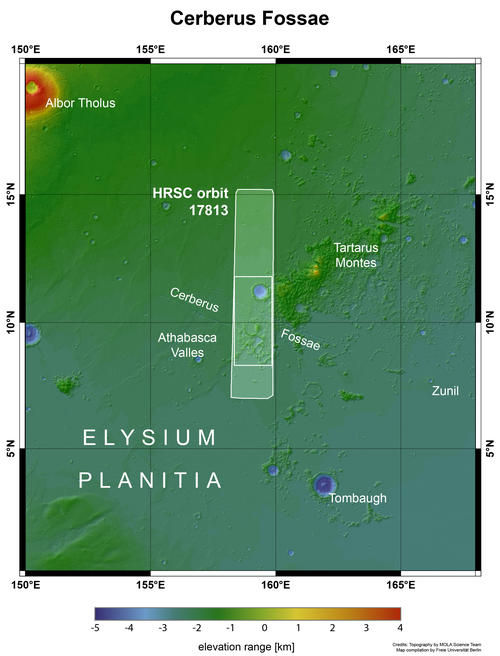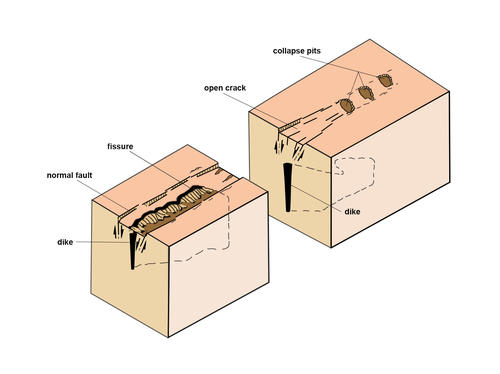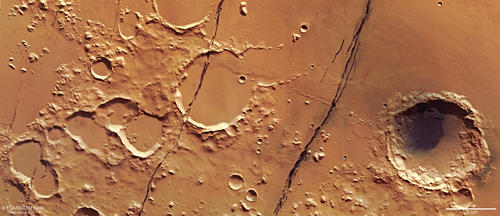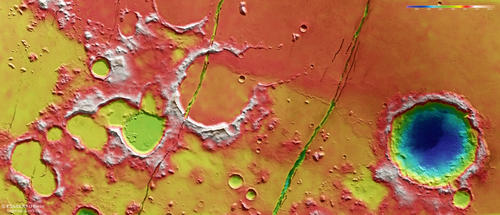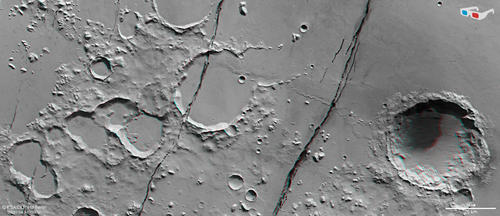Department of Earth Sciences
Service Navigation
Recent tectonics on Mars in the Cerberus Fossae
The elongated trenches pictured in these images taken by the High Resolution Stereo Camera (HRSC) on Mars Express, are denoted Cerberus Fossae. These prominent steep-walled volcanotectonic fissures served as pathways for lava and groundwater to escape to the surface of Mars millions of years ago.
» Read more about fissure formation in the main article (below the gallery) ...
Gallery • Location and Tectonics
Cerberus Fossae context map
Image Credit: MOLA Science Team/FU Berlin
Gallery • HRSC Images
Cerberus Fossae color image
Image Credit: ESA/DLR/FU Berlin
Cerberus Fossae color-coded terrain model
Image Credit: ESA/DLR/FU Berlin
Cerberus Fossae anaglyph
Image Credit: ESA/DLR/FU Berlin
Main article 'Recent tectonics on Mars in the Cerberus Fossae'
» Read more about the Cerberus Fossae fissures
The Cerberus Fossae are two parallel extensional faults that run almost 1000 kilometres across a young volcanic plain in the Elysium Planitia region. The two trenches run almost exactly parallel to one another and stretch from northwest to southeast. They are extremely steep-sided throughout and in some places cut almost vertically down through the layers of lava. This is an indication that the trenches are still very young, as over time erosion causes rock to break off from steep slopes and edges, so that the gradient of the slopes become increasingly shallow.
The few impact craters on the volcanic plain also indicate that the landscape here cannot be very old. The age of the lava flows can be determined quite by counting all of the craters and measuring their various diameters, and comparing this with other areas of Mars. This method of determining the age of geological surfaces can be applied to all bodies in the Solar System that have a solid surface. Scientists therefore assume that parts of this plain were flooded with low viscosity lava in the recent geological past, possibly even less than 100 million years ago. Lava also rose to the surface out of the Cerberus Fossae (and later presumably so did groundwater). This makes the near-Equator region of the Cerberus Fossae one of the youngest geological structures on Mars.
The Cerberus Fossae are tectonic features originating most likely from dilational faulting or from subsidence due to dike emplacement. Rounded collapse pits observed in the northern Cerberus Fossae indicate an early stage of graben subsidence, and are particularly evident in the northern part of the Cerberus Fossae. Besides, numerous volcanic dikes formed in the Martian past in the north-western volcanic region of Elysium, which is home to the 12.5 kilometre-high volcano Elysium Mons. Dike emplacement induces deformation and can lead to the formation of fissures and graben at the surface above the dike.
The outflow channel system Athabasca Valles, which rises in the Cerberus Fossae can bee seen to the west of the image shown here. Presumably, the Cerberus Fossae fissures have ruptured the Martian crust millions of years ago to a certain depth, to be able to discharge lava from a volcanic source as well as groundwater.
High Resolution Stereo Camera (HRSC)
Information to image origin and processing
The images were acquired by the HRSC (High Resolution Stereo Camera) on 27 January 2018 during Mars Express Orbit 17813. The ground resolution is approximately 16 meters per pixel and the images are centered at about 159° East and 10° North. The color image was created using data from the nadir channel, the field of view which is aligned perpendicular to the surface of Mars, and the color channels of the HRSC. The oblique perspective view was generated using data from the HRSC stereo channels. The anaglyph, which provides a three-dimensional view of the landscape when viewed using red-green or red-blue glasses, was derived from data acquired by the nadir channel and the stereo channels. The color-coded topographic view is based on a digital terrain model (DTM) of the region, from which the topography of the landscape can be derived. The reference body for the HRSC-DTM is a Mars sphere.
The systematic processing of the camera data took place at the DLR Institute for Planetary Research in Berlin-Adlershof. The working group of Planetary Science and Remote Sensing at Freie Universität Berlin used the data to create the image products shown here.
Images: ESA/DLR/FU Berlin, CC BY-SA 3.0 IGO
Copyright Notice:
Where expressly stated, images are licenced under the Creative Commons Attribution-ShareAlike 3.0 IGO (CC BY-SA 3.0 IGO) licence. The user is allowed to reproduce, distribute, adapt, translate and publicly perform it, without explicit permission, provided that the content is accompanied by an acknowledgement that the source is credited as 'ESA/DLR/FU Berlin', a direct link to the licence text is provided and that it is clearly indicated if changes were made to the original content. Adaptation / translation / derivatives must be distributed under the same licence terms as this publication.
The High Resolution Stereo Camera was developed at the German Aerospace Center (DLR) and built in collaboration with partners in industry (EADS Astrium, Lewicki Microelectronic GmbH and Jena-Optronik GmbH). The science team, which is headed by Principal Investigator (PI) Prof. Dr. Ralf Jaumann, consists of 52 co-investigators from 34 institutions and 11 countries. The camera is operated by the DLR Institute of Planetary Research in Berlin-Adlershof.
